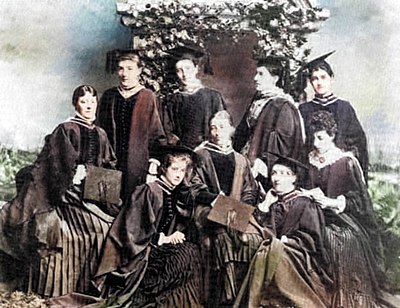The term "The Nine Graces" or Nine Muses referred to the nine women who were the first to be awarded degrees from the Royal University of Ireland in 1884. They were the first women in Great Britain or Ireland to be awarded degrees. Five of the women gained honours and four others also passed. Most of these women had received some of their teaching in Alexandra College.[1][2][3][4]

... the long procession of hooded and gowned male graduates ... the girls coming last. As soon as they appeared, there was a burst of applause. They looked exceedingly well in their black gowns, hoods lined with white fur and tasseled caps, even the plain ones, and the ordinary looking ones appeared to advantage ... The Duke [of Abercorn] arose and made a rather long speech - quoted that hackneyed old line about 'sweet girl graduates'. Jessie Twemlow, Marion Kelly, Miss Sands and the Chief [Isabella Mulvany] looked especially well; not a bit the typical blue stocking which I was glad to see, since Chief Justice Morris having only seen Alice Oldham, pronounced them 'an ugly lot'.
Mary Hayden, Diaries of Mary T. Hayden, 22 October 1884.[5]
The Nine Graces edit
- Isabella Mulvany, headmistress of Alexandra School, activist for women's education
- Alice Oldham (honours in logic, metaphysics, history of philosophy), activist for women's education, teacher
- Jessie Twemlow, later Meredith (honours in modern literature)[6]
- Marion Kelly (honours in modern literature)
- Annie Mary Sands (Rutland School)[7]
- Eliza Wilkins
- Charlotte M. Taylor (honours in music and modern literature)
- Louisa M. McIntosh (honours in modern literature)
- Emily E. Eberle[8]
Other reading edit
- Knowing Their Place: The Intellectual Life of Women in the 19th Century, Professor Brendan Walsh, The History Press, 15 Jul 2014
References edit
- ^ "Alice Oldham and the admission of women to Trinity College, 1892-1904" (PDF).
- ^ Debbie Blake (2015). Daughters of Ireland: Exceptional Irish Women. The History Press. p. 256.
- ^ Deirdre Raftery and Susan M. Parkes. Female education in Ireland 1700-1900: Minerva or Madonna. Facoltà di Scienze della Formazione, Università di Foggia, Italy.
- ^ "Growth of university education for women". Discovering Women in Irish History. Retrieved 17 April 2019.
- ^ "4.8.4 Growth of university education for women". womeninhistory.scoilnet.ie.
- ^ "Jessica (Jessie) TWEMLOW". The Irish Merediths. Retrieved 1 October 2020.
- ^ The Irish Times (Thursday, October 23, 1884), page 5.
- ^ (1858-1908). She later trained as a doctor. See Rosemary Power, The Moravian Burial Ground at Whitechurch, County Dublin (London: The Moravian Book Room, 2014), 28-9.
"Record of Events: Royal University of Ireland -- Conferring of Degrees." The Englishwoman's Review of Social and Industrial Questions, New Series, Vol. 15, no. 139 (Nov. 15, 1884), pp. 517-521. Garland. 1884. ISBN 9780824037413. Retrieved 1 October 2020.
{{cite book}}:|website=ignored (help)